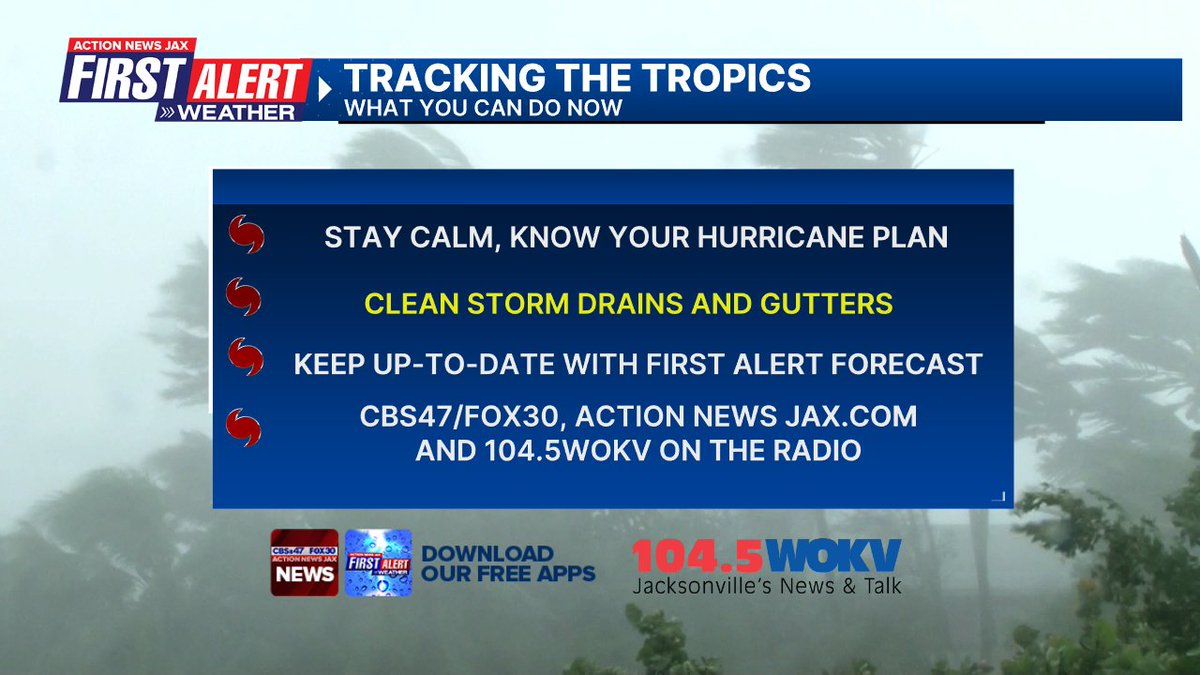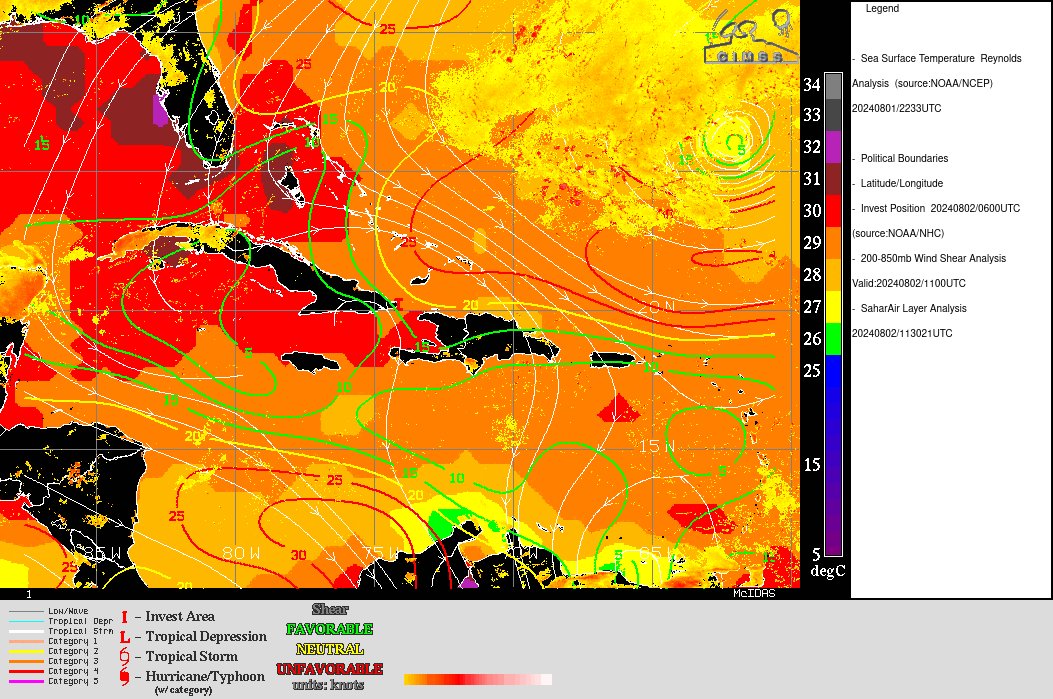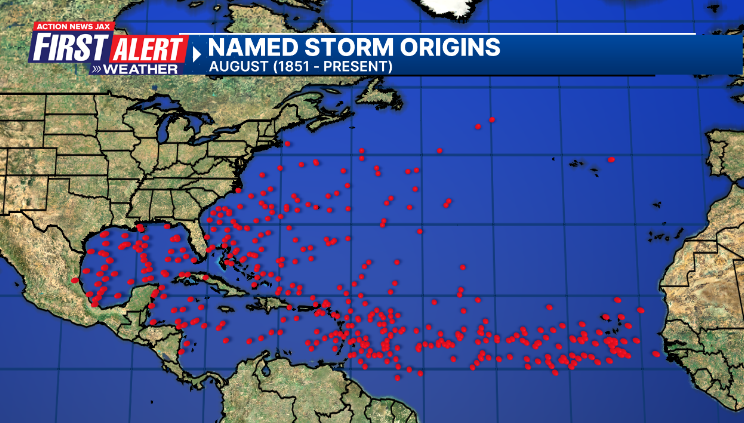Jacksonville, Fl. — The “Buresh Bottom Line”: Always be prepared!.....First Alert Hurricane Preparation Guide... City of Jacksonville Preparedness Guide... Georgia Hurricane Guide.
STAY INFORMED: Get the * FREE * First Alert Weather app
FREE NEWS UPDATES, ALERTS: Action News Jax app for Apple | For Android
WATCH “Preparing for the Storm”
WATCH “The Ins & Outs of Hurricane Season”
READ the First Alert Hurricane Center “Preparation Guide”
***** ALWAYS CHECK & RE-CHECK THE LATEST FORECAST & UPDATES! *****
*** LOCAL (Jacksonville/NE Fl./SE Ga.) IMPACTS FROM THE TROPICS: Heavy rain & flooding threat, isolated tornadoes/waterspouts late Sunday-Monday & into Tuesday.
The “Buresh Bottom Line”:
* the probability of a tropical system near Florida looks very high late Sunday night/early next week.
* Northeast Florida/Southeast Georgia concerns are centered around heavy rain - possibly very heavy, moderately rough seas & surf, a high rip current risk & isolated tornadoes/waterspouts. Winds should be gusty but not severe.
* Florida is the “fork in the road” for direction of movement & speed.
* There is the potential for fairly rapid strengthening upon approach to landfall.
* Heads up for all of Florida, the Central & Eastern Gulf coast & the U.S. east coast.
* Gusty rain & t’storm squalls will impact Hispaniola & nearby islands, Central & Southern Bahamas as well as Jamaica & Cuba into Sunday... & most of Florida later Sunday/early next week but already impacting Central & especially South Florida.
* A reminder that Jax/NE Fl./SE Ga. will be on the “messy” east side of the storm.
* Realize impacts from Debby will occur many miles from the center & OUTSIDE of the forecast cone.
* Forecasts are still in flux & subject to change
The Atlantic Basin Overview:
A Hurricane WARNING: The Florida Gulf coast from the Suwannee River to the Ochlockonee River A Hurricane Watch is in effect for... Florida coast west of the Ochlockonee River to Indian Pass ... Florida coast east of the Suwannee River to Yankeetown. A Tropical Storm WARNING: The Florida Keys west of the Seven Mile Bridge including the Dry Tortugas ... West coast of the Florida peninsula from south of the Suwannee River to East Cape Sable. A Tropical Storm WATCH: The Florida Keys north of the Seven Mile Bridge to the Channel 5 Bridge ... The Florida coast west of Indian Pass to Mexico Beach A Storm Surge WARNING: Aripeka northward to Indian Pass. A Storm Surge WATCH: Bonita Beach northward to Aripeka, including Tampa Bay and Charlotte Harbor
Forecast models are coming into generally better agreement regarding the possible/probable development & evolution of a tropical wave that will emerge over the SE Gulf of Mexico....
(1) “Debby” - The 4th Atlantic named storm of the season continues to steadily move westward within a moist atmosphere & now generally low shear not to mention very warm water. Now that the storm has emerged over the Southeast Gulf Saturday & is organizing/strengthening.
Well - let’s give a tip of the hat to the GFS model - at least so far. It’s clear a more west is the call as the wave is being driven west by low level prevailing easterly (east to west) winds. Virtually all the forecast models are now in agreement with at least a strong tropical storm if not hurricane over the Eastern Gulf before a Fl. landfall. Other than proximity to land, it would appear most parameters - water temps., atmospheric moisture (humidity) & shear favor development. If the disturbance stays over the Gulf longer & a little more west, a stronger scenario has to be considered.
Debby will slow upon approach to Florida & there are indications of perhaps a very slow moving tropical cyclone after landfall as steering currents collapse. The result could be a storm capable of dumping 1-2+ FEET of rain along & east of the track.
The track is coming down to - as expected - a potential alleyway between sprawling upper level high pressure cells - the Bermuda high & a summer-long second cell over the Souther/SW U.S. & an upper level trough digging southeast over the Eastern U.S. This will be in interesting & difficult to predict interaction as the upper level trough will add some upper level “ventilation” for Debbie adding to the potential for greater intensification. This interaction will also be key to whether or not Debby continues moving or gets left behind.
It is important to realize & understand that while forecast models have come into much better agreement, there is still plenty of room for possibly significant forecast changes &, therefore impacts... especially if the incoming upper level trough fails to actually pick up Debby.
So *For the moment* it would appear Debby will be at hurricane strength by landfall with a painfully slow move northeast & inland thereafter.
Keep in mind impacts from Debby will extend well away from the center...



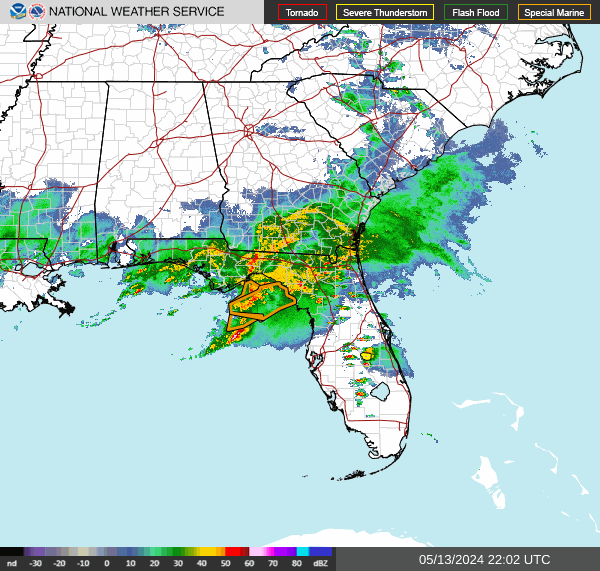
Radar imagery from S. Florida Water Management District:




500mb - about 30,000 feet - Saturday (08/03) Euro forecast:



Composite map below shows water temps. (plenty warm - 85-90F+)... wind shear (decreasing markedly)... & dry air (not much):
Wind shear dropping off dramatically over the Fl. Straits, Gulf:
(2) A couple of active tropical wave are over the Central & Eastern Atlantic. Forecast models are not too excited about the waves, but it’s something to watch as the African “wave train” starts to ramp up & the MJO pulse spreads eastward.
The velocity potential anomalies map below shows a lot of sinking air (brown lines) - & a lack of convection - over the Atlantic Basin to the far East Pacific while rising air (green lines) is over the Central & West Pacific more convection is notable. Often the green areas (MJO pulse) will correlate with increased tropical activity. So it’s the W. Pacific that will be more active now but this pulse should move eastward - signs of which we’re already seeing - helping to set off a return to a more active Atlantic through at least the middle of August.
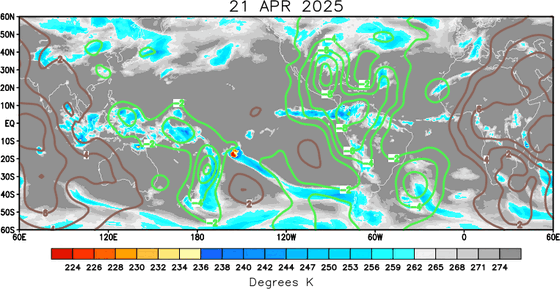
REMEMBER WHEN A TROPICAL STORM OR HURRICANE IS APPROACHING: Taping windows is *not* recommended & will not keep glass from breaking. Instead close curtains & blinds.
Realize the forecast cone (”cone of uncertainty”) is the average forecast error over a given time - out to 5 days - & *does not* indicate the width of the storm &/or where damage might occur.
The upper oceanic heat content (UOHC) [tropical cyclone heat potential/TCHP] across the SW Atlantic, Gulf & Caribbean is unseasonably high for this time of year:






Water vapor loop (dark blue/yellow is dry mid & upper level air):


August tropical cyclone origins (early season breeding grounds are the Gulf &/or Western Caribbean:
Averages below based on climatology for the Atlantic Basin for August (1 hurricane so far, 3 tropical storms):
Wind shear (red - strong shear; green - low shear):



Saharan dust spreads west each year from Africa driven by the prevailing winds (from east to west over the Atlantic). Dry air = yellow/orange/red/pink. Widespread dust is indicative of dry air that *can* interfere with the development of tropical cyclones. However, sometimes “wanna’ be” waves will just wait until they get to the other side of - or away from - the dust plume then try to develop if other conditions are favorable. In my personal opinion, there is way too much “hoopla” about the presence of Saharan dust & how it relates to tropical cyclones. In any case, the peak of Saharan dust typically is in June & July.

2024 names..... “Ernesto” is the next name on the Atlantic list (names are picked at random by the World Meteorological Organization... repeat every 6 years). Historic storms are retired [Florence & Michael in ’18 (the last time this year’s list was used)... Dorian in ’19 & Laura, Eta & Iota in ‘20, Ida in ‘21 & Fiona & Ian in ‘22]). In fact, this year’s list of names is rather infamous because of the ‘04 season when Charley, Frances, Jeanne & Ivan - all retired names - hit Florida within a matter of about 6 weeks. The WMO decided - beginning in 2021 - that the Greek alphabet will be no longer used & instead there will be a supplemental list of names if the first list is exhausted (has only happened three times - 2005, 2020 & 2021). The naming of tropical cyclones began on a consistent basis in 1953. More on the history of naming tropical cyclones * here *.





East Atlantic:





Mid & upper level wind shear (enemy of tropical cyclones) analysis (CIMMS). The red lines indicate strong shear:
Water vapor imagery (dark blue indicates dry air):

Deep oceanic heat content over the Gulf, Caribbean & deep tropical Atlantic. The colors will brighten greatly as the water warms to greater depths deeper into the season:

Sea surface temp. anomalies:


SE U.S. surface map:

Surface analysis centered on the tropical Atlantic:

Surface analysis of the Gulf:

Caribbean:

Atlantic Basin wave period forecast for 24, 48, 72 & 96 hours respectively:





East & Central Pacific:
“Carlotta” has formed over the Eastern Pacific & has become the first hurricane of the season over the E. Pacific - one of the latest dates for such an occurrence on record. Nevertheless - no impact to land areas while moving west.
“Daniel” has joined Carlotta but is also no threat to any land areas.







West Pacific:

Global tropical activity:



Cox Media Group



